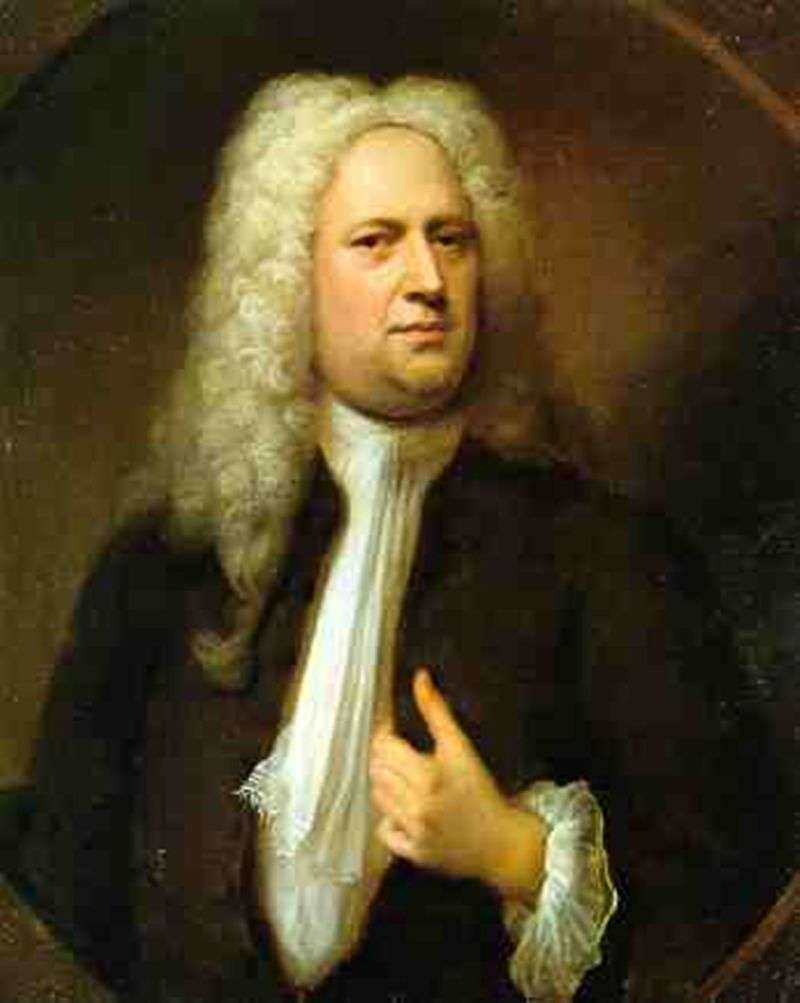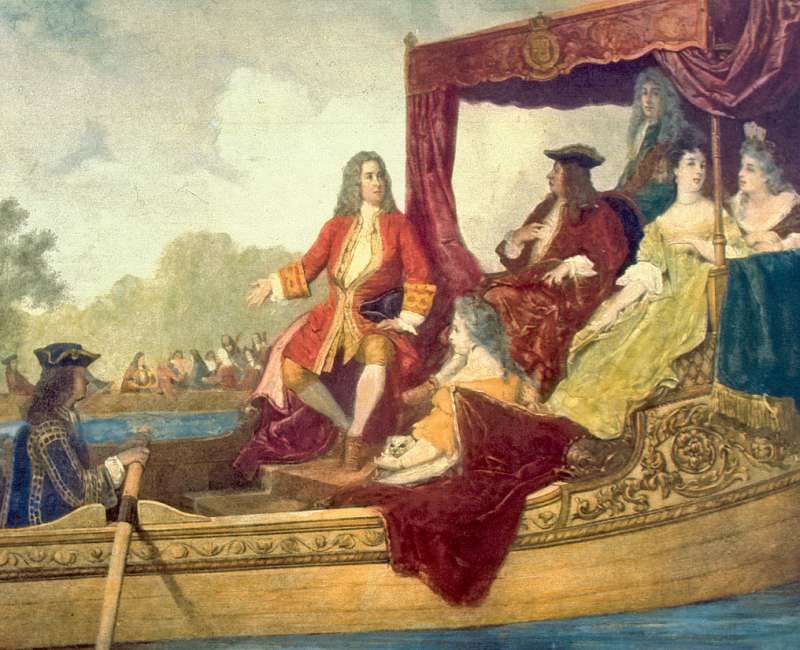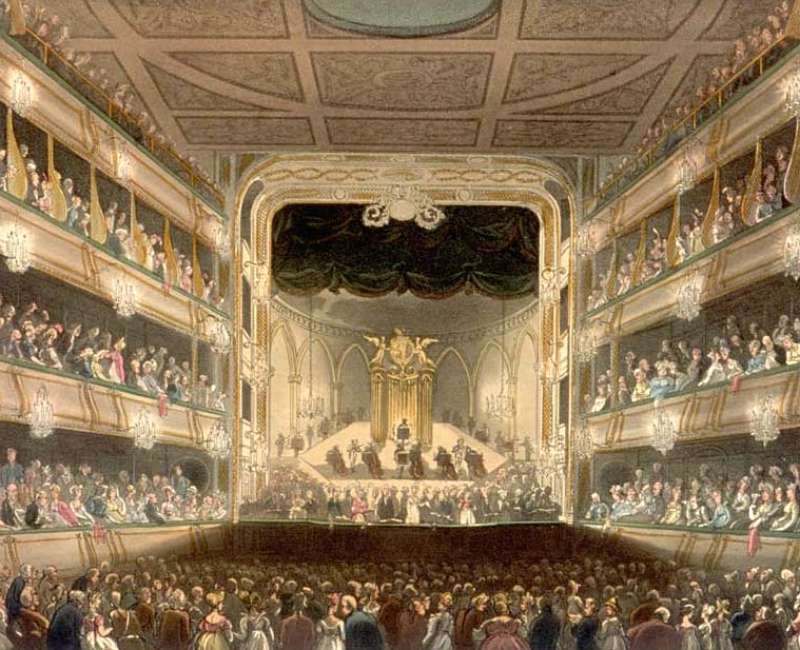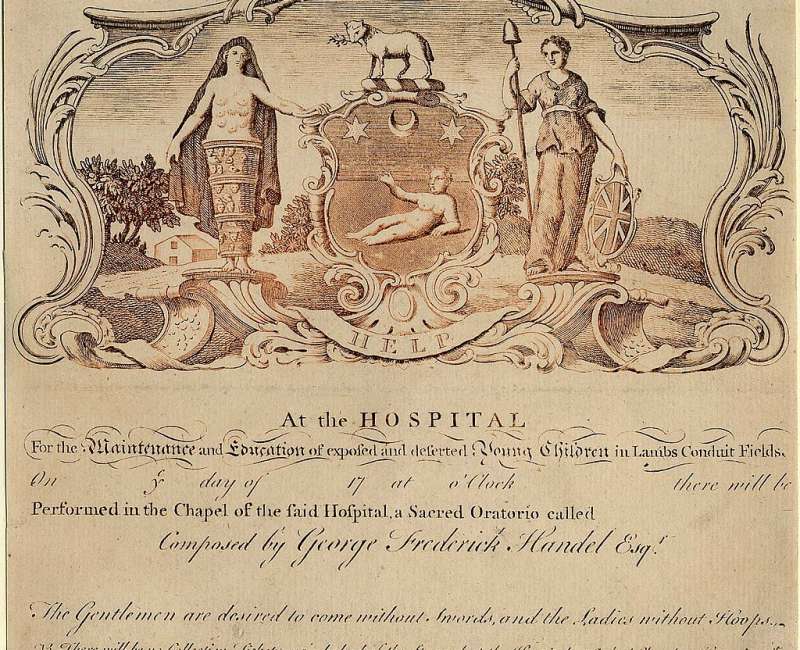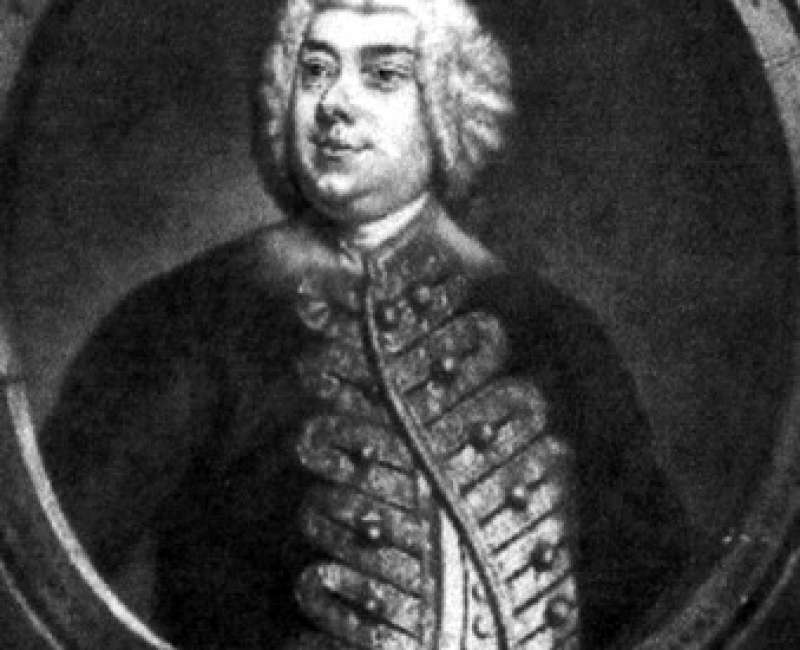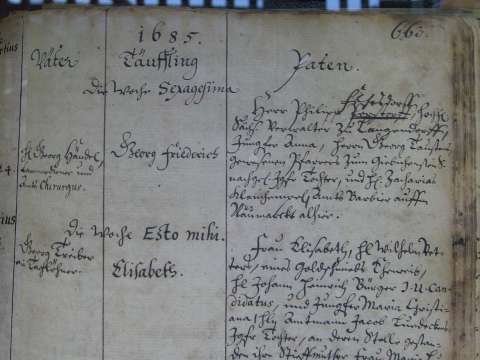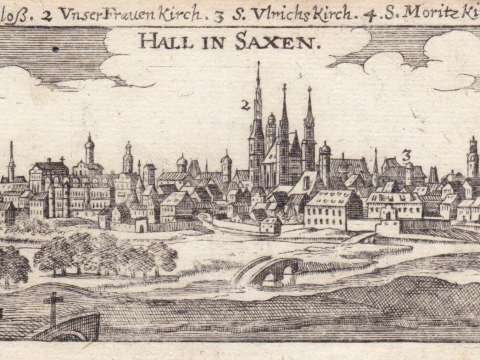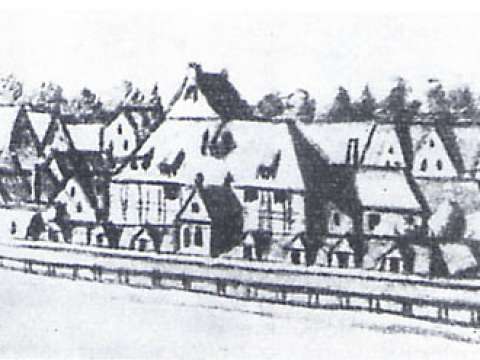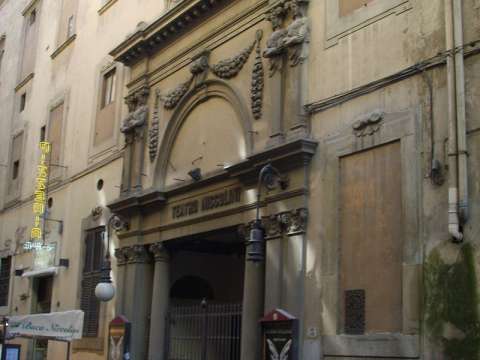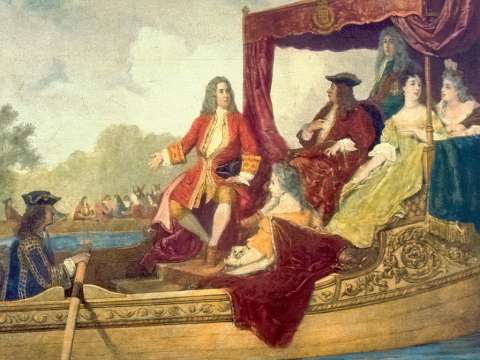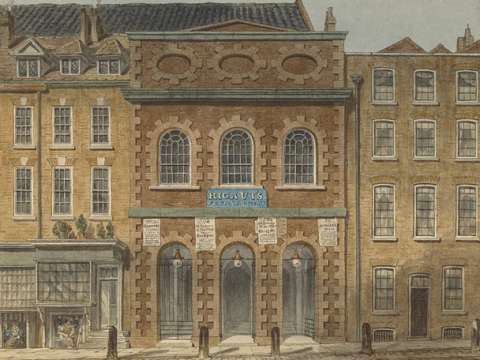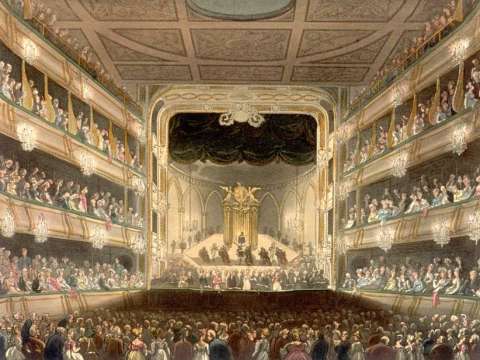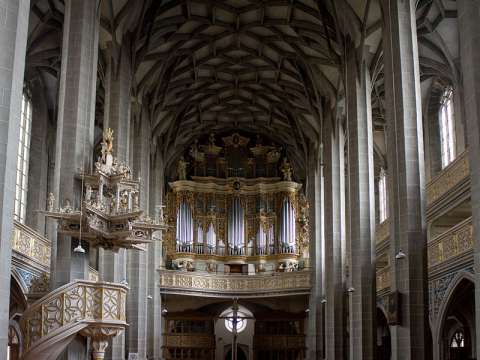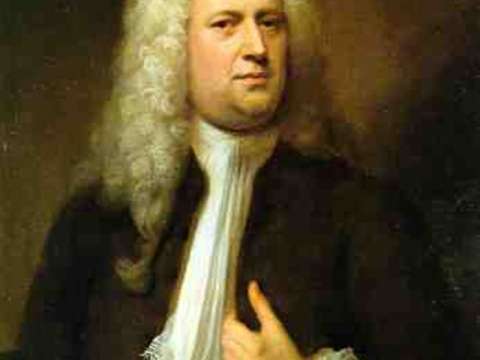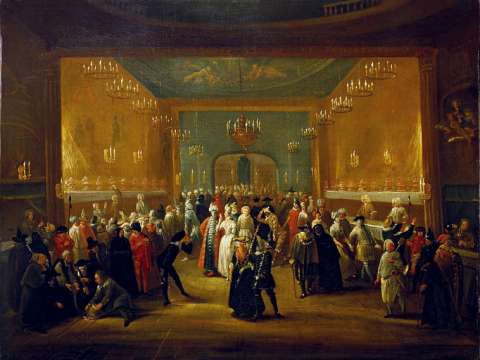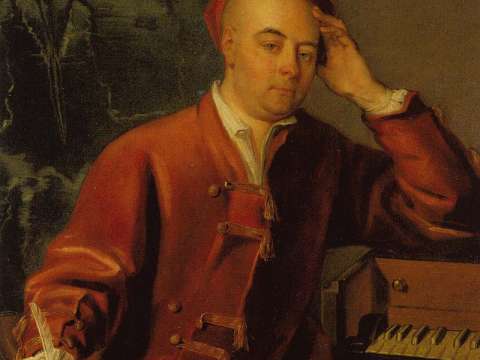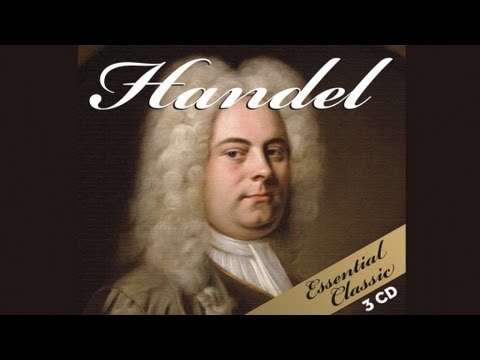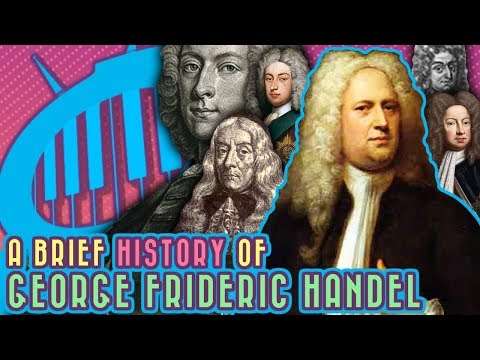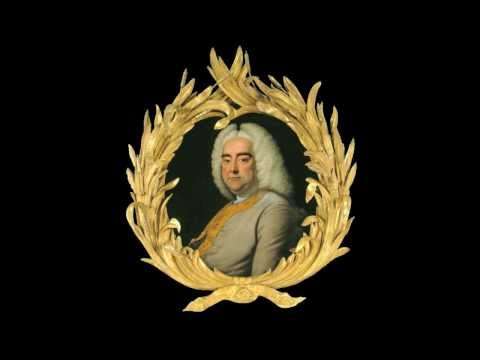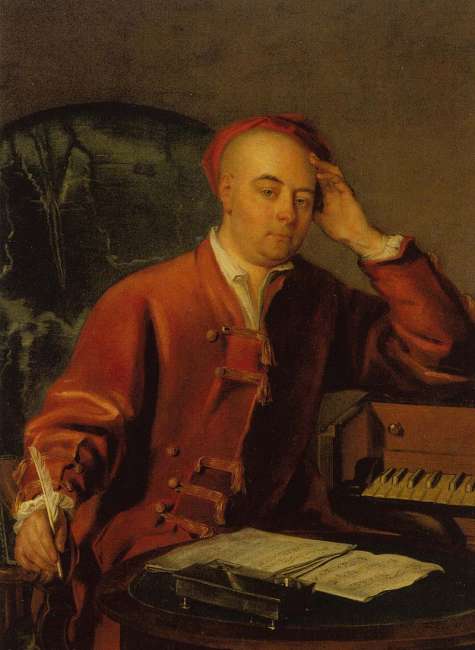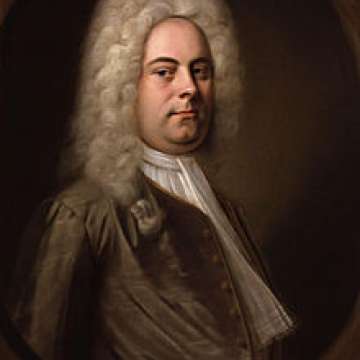

George Frideric Handel (1685-1759)

I should be sorry if I only entertained them. I wished to make them better.
Frideric Handel was a German, later British, Baroque composer who spent the bulk of his career in London, becoming well known for his operas, oratorios, anthems, concerti grossi and organ concertos. Handel received important training in Halle and worked as a composer in Hamburg and Italy before settling in London in 1712; he became a naturalised British subject in 1727. He was strongly influenced both by the great composers of the Italian Baroque and by the middle-German polyphonic choral tradition. He would become a huge influence on classical composers such as Mozart and Beethoven.
Within fifteen years, Handel had started three commercial opera companies to supply the English nobility with Italian opera. Musicologist Winton Dean writes that his operas show that "Handel was not only a great composer; he was a dramatic genius of the first order." As Alexander's Feast 1736 was well received, Handel made a transition to English choral works. After his success with Messiah 1742 he never composed an Italian opera again. Almost blind, and having lived in England for nearly fifty years, he died in 1759, a respected and rich man. His funeral was given full state honours, and he was buried in Westminster Abbey in London.
Handel is regarded as one of the greatest composers of the Baroque era, with works such as Messiah, Water Music, and Music for the Royal Fireworks remaining steadfastly popular. One of his four coronation anthems, Zadok the Priest 1727, composed for the coronation of George II, has been performed at every subsequent British coronation, traditionally during the sovereign's anointing. Another of his English oratorios, Solomon 1748, has also remained popular, with the Sinfonia that opens act 3 known more commonly as "The Arrival of the Queen of Sheba" featuring at the 2012 London Olympics opening ceremony. Handel composed more than forty opera serias in over thirty years, and since the late 1960s, with the revival of baroque music and historically informed musical performance, interest in Handel's operas has grown.
Early years
Family
Handel was born in 1685 in Halle, Duchy of Magdeburg then part of Brandenburg-Prussia, to Georg Händel and Dorothea Taust. His father, aged sixty-three when George Frideric was born, was an eminent barber-surgeon who served the court of Saxe-Weissenfels and the Margraviate of Brandenburg.

Georg Händel senior was the son of a coppersmith, Valentin Händel 1582–1636, who had emigrated from Eisleben in 1608 with his first wife Anna Belching, the daughter of a master coppersmith. They were Protestants and chose reliably Protestant Saxony over Silesia, a Habsburg possession, as religious tensions mounted in the years before the Thirty Years War. Halle was a relatively prosperous city, home of a salt-mining industry and centre of trade and member of the Hanseatic League. The Margrave of Brandenburg became the administrator of the archiepiscopal territories of Mainz, including Magdeburg when they converted, and by the early 17th century held his court in Halle, which attracted renowned musicians. Even the smaller churches all had "able organists and fair choirs", and humanities and the letters thrived Shakespeare was performed in the theatres early in the 17th century. The Thirty Years War brought extensive destruction to Halle, and by the 1680s it was impoverished. However, since the middle of the war the city had been under the administration of the Duke of Saxony, and soon after the end of the war he would bring musicians trained in Dresden to his court in Weissenfels.

The arts and music, however, flourished only among the higher strata not only in Halle but throughout Germany, of which Handel's family was not a member. Georg Händel senior was born at the beginning of the war, and was apprenticed to a barber in Halle at the age of 14, after his father died. When he was 20, he married the widow of the official barber-surgeon of a suburb of Halle, inheriting his practice. With this, Georg determinedly began the process of becoming self-made; by dint of his "conservative, steady, thrifty, unadventurous" lifestyle, he guided the five children he had with Anna who reached adulthood into the medical profession except his youngest daughter, who married a government official. Anna died in 1682. Within a year Georg married again, this time to the daughter of a Lutheran minister, Pastor Georg Taust of the Church of St. Bartholomew in Giebichenstein, who himself came from a long line of Lutheran pastors. Handel was the second child of this marriage; the first son was stillborn. Two younger sisters were born after the birth of George Frideric: Dorthea Sophia, born 6 October 1687, and Johanna Christiana, born 10 January 1690.
Early education
Early in his life Handel is reported to have attended the Gymnasium in Halle, where the headmaster, Johann Praetorius , was reputed to be an ardent musician. Whether Handel remained there, and if he did for how long, is unknown, but many biographers suggest that he was withdrawn from school by his father, based on the characterization of him by Handel's first biographer, John Mainwaring. Mainwaring is the source for almost all information little as it is of Handel's childhood, and much of that information came from J.C. Smith, Jr., Handel's confidant and copyist. Whether it came from Smith or elsewhere, Mainwaring frequently relates misinformation. It is from Mainwaring that the portrait comes of Handel's father as implacably opposed to any musical education. Mainwaring writes that Georg Händel was "alarmed" at Handel's very early propensity for music, "took every measure to oppose it", including forbidding any musical instrument in the house and preventing Handel from going to any house where they might be found. This did nothing to dampen young Handel's inclination; in fact, it did the reverse. Mainwaring tells the story of Handel's secret attic spinet: Handel "found means to get a little clavichord privately convey'd to a room at the top of the house. To this room he constantly stole when the family was asleep". Although both John Hawkins and Charles Burney credited this tale, Schoelcher found it nearly "incredible" and a feat of "poetic imagination" and Lang considers it one of the unproven "romantic stories" that surrounded Handel's childhood. But Handel had to have had some experience with the keyboard to have made the impression in Weissenfels that resulted in his receiving formal musical training.
Musical education
Sometime between the ages of seven and nine, Handel accompanied his father to Weissenfels where he came under the notice of one whom Handel thereafter always regarded throughout life as his benefactor, Duke Johann Adolf I. Somehow Handel made his way to the court organ in the palace chapel of the Holy Trinity, where he surprised everyone with his playing. Overhearing this performance and noting the youth of the performer caused the Duke, whose suggestions were not to be disregarded, to recommend to Georg Händel that Handel be given musical instruction. Handel's father engaged the organist at the Halle parish church, the young Friedrich Wilhelm Zachow, to instruct Handel. Zachow would be the only teacher that Handel ever had. Because of his church employment, Zachow was an organist "of the old school", reveling in fugues, canons and counterpoint. But he was also familiar with developments in music across Europe and his own compositions "embraced the new concerted, dramatic style". When Zachow discovered the talent of Handel, he introduced him "to a vast collection of German and Italian music, which he possessed, sacred and profane, vocal and instrumental compositions of different schools, different styles, and of every master". Many traits considered "Handelian" can be traced back to Zachow's music. At the same time Handel continued practice on the harpsichord, learned violin and organ, but according to Burney his special affection was for the hautbois oboe. Schoelcher speculates that his youthful devotion to the instrument explains the large number of pieces he composed for oboe.

With respect to instruction in composition, in addition to having Handel apply himself to traditional fugue and cantus firmus work, Zachow, recognising Handel's precocious talents, systematically introduced Handel to the variety of styles and masterworks contained in his extensive library. He did this by requiring Handel to copy selected scores. "I used to write like the devil in those days", Handel recalled much later. Much of this copying was entered into a notebook that Handel maintained for the rest of his life. Although it has since disappeared, the notebook has been sufficiently described to understand what pieces Zachow wished Handel to study. Among the chief composers represented in this exercise book were Johann Krieger, an "old master" in the fugue and prominent organ composer, Johann Caspar Kerll, a representative of the "southern style" after his teacher Frescobaldi and imitated later by Handel, Johann Jakob Froberger, an "internationalist" also closely studied by Buxtehude and Bach, and Georg Muffat, whose amalgam of French and Italian styles and his synthesis of musical forms influenced Handel.

Mainwaring writes that during this time Zachow had begun to have Handel assume some of his church duties. Zachow, Mainwaring asserts, was "often" absent, "from his love of company, and a cheerful glass", and Handel therefore performed on organ frequently. What is more, according to Mainwaring, Handel began composing, at the age of nine, church services for voice and instruments "and from that time actually did compose a service every week for three years successively." Mainwaring ends this chapter of Handel's life by concluding that three or four years had been enough to allow Handel to surpass Zachow, and Handel had become "impatient for another situation"; "Berlin was the place agreed upon." Carelessness with dates or sequences and possibly imaginative interpretation by Mainwaring makes this period confused.
After the death of Handel's father
Handel's father died on 11 February 1697. It was German custom for friends and family to compose funeral odes for a substantial burgher like Georg, and young Handel discharged his duty with a poem dated 18 February and signed with his name and in deference to his father's wishes "dedicated to the liberal arts." At the time Handel was studying either at Halle's Lutheran Gymnasium or the Latin School.
Mainwaring has Handel traveling to Berlin the next year, 1698. The problem with Mainwaring as an authority for this date, however, is that he tells of how Handel's father communicated with the "king" during Handel's stay, declining the Court's offer to send Handel to Italy on a stipend and that his father died "after his return from Berlin." But since Georg Händel died in 1697, either the date of the trip or Mainwaring's statements about Handel's father must be in error. Early biographers solved the problem by making the year of the trip 1696, then noting that at the age of 11 Handel would need a guardian, so they have Handel's father or a friend of the family accompany him, all the while puzzling over why the elder Handel, who wanted Handel to become a lawyer, would spend the sum to lead his son further into the temptation of music as a career. Schoelcher for example has Handel traveling to Berlin at 11, meeting both Bononcini and Attilio Ariosti in Berlin and then returning at the direction of his father. But Ariosti was not in Berlin before the death of Handel's father, and Handel could not have met Bononcini in Berlin before 1702. Modern biographers either accept the year as 1698, since most reliable older authorities agree with it, and discount what Mainwaring says about what took place during the trip or assume that Mainwaring conflated two or more visits to Berlin, as he did with Handel's later trips to Venice.
University
Perhaps to fulfill a promise to his father or simply because he saw himself as "dedicated to the liberal arts," on 10 February 1702 Handel matriculated at the University of Halle. That university had only recently been founded. In 1694 the Elector of Brandenburg Frederick III later Prussian King Frederick I created the school, largely to provide a lecture forum for the jurist Christian Thomasius who had been expelled from Leipzig for his liberal views. Händel did not enroll in the faculty of law, although he almost certainly attended lectures. Thomasius was an intellectual and academic crusader who was the first German academic to lecture in German and also denounced witch trials. Lang believes that Thomasius instilled in Händel a "respect for the dignity and freedom of man's mind and the solemn majesty of the law," principles that would have drawn him to and kept him in England for half a century. Handel also there encountered theologian and professor of Oriental languages August Hermann Francke, who was particularly solicitous of children, particularly orphans. The orphanage he founded became a model for Germany, and undoubtedly influenced Handel's own charitable impulse, when he assigned the rights of Messiah to London's Foundling Hospital.

Shortly after commencing his university education, Handel though Lutheran on 13 March 1702 accepted the position of organist at the Calvinist Cathedral in Halle, the Domkirche, replacing J.C. Leporin, for whom he had acted as assistant. The position, which was a one-year probationary appointment showed the foundation he had received from Zachow, for a church organist and cantor was a highly prestigious office. From it he received 5 thalers a year and lodgings in the run-down castle of Moritzburg.
Around this same time Handel made the acquaintance of Telemann. Four years Handel's senior, Telemann was studying law and assisting cantor Johann Kuhnau Bach's predecessor at the Thomaskirche there. Telemann recalled forty years later in an autobiography for Mattheson's Grundlage: "The writing of the excellent Johann Kuhnau served as a model for me in fugue and counterpoint; but in fashioning melodic movements and examining them Handel and I were constantly occupied, frequently visiting each other as well as writing letters."
Halle compositions
Although Mainwaring records that Handel wrote weekly when assistant to Zachow and as probationary organist at Domkirche part of his duty was to provide suitable music, no sacred compositions from his Halle period can now be identified. Mattheson, however, summarised his opinion of Handel's church cantatas written in Halle: "Handel in those days set very, very long arias and sheerly unending cantatas which, while not possessing the proper knack or correct taste, were perfect so far as harmony is concerned."
Early chamber works do exist, but it is difficult to date any of them to Handel's time in Halle. Many historians until recently followed Chrysander and designated the six trio sonatas for two oboes and basso continuo as his first known composition, supposedly written in 1696 when Handel was 11. Lang doubts the dating based on a handwritten date of a copy 1700 and stylistic considerations. Lang writes that the works "show thorough acquaintance with the distilled sonata style of the Corelli school" and are notable for "the formal security and the cleanness of the texture." Hogwood considers all of the oboe trio sonatas spurious and even suggests that some parts cannot be performed on oboe. That authentic manuscript sources do not exist and that Handel never recycled any material from these works make their authenticity doubtful. Other early chamber works were printed in Amsterdam in 1724 as opus 1, but it is impossible to tell which are early works in their original form, rather than later re-workings by Handel, a frequent practice of his.
From Halle to Italy
Handel's probationary appointment to Domkirche expired in March 1703. By July Handel was in Hamburg. Since he left no explanation for the move biographers have offered their own speculation. Burrows believes that the answer can be found by untangling Mainwaring's confused chronology of the trip to Berlin. Burrows dates this trip to 1702 or 1703 after his father's death and concluded that since Handel through a "friend and relation" at the Berlin court turned down Frederick's offer to subsidise his musical education in Italy with the implicit understanding that he would become a court musician on his return, Handel was no longer able to expect preferment whether as musician, lawyer or otherwise within Brandenburg-Prussia. And since he was attracted to secular, dramatic music by meeting the Italians Bononcini and Attilio Ariosti and through the influence of Telemann, Hamburg, a free city with an established opera company, was the logical choice. The question remains, however, why Handel rejected the King's offer, given that Italy was the centre of opera. Lang suggests that, influenced by the teachings of Thomasius, Handel's character was such that he was unable to make himself subservient to anyone, even a king. Lang sees Handel as someone who could not accept class distinctions that required him to regard himself as a social inferior. "What Handel craved was personal freedom to raise himself out of his provincial milieu to a life of culture." Burrows notes that like his father, Handel was able to accept royal and aristocratic favours without considering himself a court servant. And so given the embarrassed financial condition of his mother, Handel set off for Hamburg to obtain experience while supporting himself.

In 1703 he accepted a position as violinist and harpsichordist in the orchestra of the Hamburg Oper am Gänsemarkt. There he met the composers Johann Mattheson, Christoph Graupner and Reinhard Keiser. His first two operas, Almira and Nero, were produced in 1705. He produced two other operas, Daphne and Florindo, in 1708. It is unclear whether Handel directed these performances.

According to Mainwaring, in 1706 Handel travelled to Italy at the invitation of Ferdinando de' Medici. Other sources say Handel was invited by Gian Gastone de' Medici, whom Handel had met in 1703–1704 in Hamburg. De' Medici, who had a keen interest in opera, was trying to make Florence Italy's musical capital by attracting the leading talents of his day. In Italy Handel met librettist Antonio Salvi, with whom he later collaborated. Handel left for Rome and, since opera was temporarily banned in the Papal States, composed sacred music for the Roman clergy. His famous Dixit Dominus 1707 is from this era. He also composed cantatas in pastoral style for musical gatherings in the palaces of duchess Aurora Sanseverino whom Mainwaring called "Donna Laura" one of the most influential patrons from the Kingdom of Naples, and cardinals Pietro Ottoboni, Benedetto Pamphili and Carlo Colonna. Two oratorios, La resurrezione and Il trionfo del tempo, were produced in a private setting for Ruspoli and Ottoboni in 1709 and 1710, respectively. Rodrigo, his first all-Italian opera, was produced in the Cocomero theatre in Florence in 1707. Agrippina was first produced in 1709 at Teatro San Giovanni Grisostomo in Venice, owned by the Grimanis. The opera, with a libretto by Cardinal Vincenzo Grimani, ran for 27 nights successively. The audience, thunderstruck with the grandeur and sublimity of his style, applauded for Il caro Sassone "the dear Saxon" – referring to Handel's German origins.
Move to London
In 1710, Handel became Kapellmeister to German prince George, the Elector of Hanover, who in 1714 would become King George I of Great Britain and Ireland. He visited Anna Maria Luisa de' Medici and her husband in Düsseldorf on his way to London in 1710. With his opera Rinaldo, based on La Gerusalemme Liberata by the Italian poet Torquato Tasso, Handel enjoyed great success, although it was composed quickly, with many borrowings from his older Italian works. This work contains one of Handel's favourite arias, Cara sposa, amante cara, and the famous Lascia ch'io pianga.
In 1712, Handel decided to settle permanently in England. In the summer of 1713 he lived at Mr Mathew Andrews' estate in Barn Elms, Surrey. He received a yearly income of £200 from Queen Anne after composing for her the Utrecht Te Deum and Jubilate, first performed in 1713.

One of his most important patrons was The 3rd Earl of Burlington and 4th Earl of Cork, a young and extremely wealthy member of an Anglo-Irish aristocratic family. While living in the mansion of Lord Burlington, Handel wrote Amadigi di Gaula, a "magic" opera, about a damsel in distress, based on the tragedy by Antoine Houdar de la Motte.
The conception of an opera as a coherent structure was slow to capture Handel's imagination and he composed no operas for five years. In July 1717 Handel's Water Music was performed more than three times on the River Thames for the King and his guests. It is said the compositions spurred reconciliation between Handel and the King, supposedly annoyed by the composer's abandonment of his Hanover post.
Cannons 1717–19
In 1717 Handel became house composer at Cannons in Middlesex, where he laid the cornerstone for his future choral compositions in the Chandos Anthems. Romain Rolland wrote that these anthems or Psalms stood in relation to Handel's oratorios, much the same way that the Italian cantatas stood to his operas: "splendid sketches of the more monumental works." Another work, which he wrote for The 1st Duke of Chandos, the owner of Cannons, was Acis and Galatea: during Handel's lifetime it was his most performed work. Winton Dean wrote, "the music catches breath and disturbs the memory".

In 1719 the Duke of Chandos became one of the composer's important patrons and main subscribers to his new opera company, the Royal Academy of Music, but his patronage declined after Chandos lost money in the South Sea bubble, which burst in 1720 in one of history's greatest financial cataclysms. Handel himself invested in South Sea stock in 1716, when prices were low and sold before 1720.
Royal Academy of Music 1719–34
In May 1719, The 1st Duke of Newcastle, the Lord Chamberlain, ordered Handel to look for new singers. Handel travelled to Dresden to attend the newly built opera. He saw Teofane by Antonio Lotti, and engaged members of the cast for the Royal Academy of Music, founded by a group of aristocrats to assure themselves a constant supply of baroque opera or opera seria. Handel may have invited John Smith, his fellow student in Halle, and his son Johann Christoph Schmidt, to become his secretary and amanuensis. By 1723 he had moved into a Georgian house at 25 Brook Street, which he rented for the rest of his life. This house, where he rehearsed, copied music and sold tickets, is now the Handel House Museum. During twelve months between 1724 and 1725, Handel wrote three outstanding and successful operas, Giulio Cesare, Tamerlano and Rodelinda. Handel's operas are filled with da capo arias, such as Svegliatevi nel core. After composing Silete venti, he concentrated on opera and stopped writing cantatas. Scipio, from which the regimental slow march of the British Grenadier Guards is derived, was performed as a stopgap, waiting for the arrival of Faustina Bordoni.

In 1727 Handel was commissioned to write four anthems for the Coronation ceremony of King George II. One of these, Zadok the Priest, has been played at every British coronation ceremony since. In 1728 John Gay's The Beggar's Opera, which made fun of the type of Italian opera Handel had popularised in London, premiered at Lincoln's Inn Fields Theatre and ran for 62 consecutive performances, the longest run in theatre history up to that time. After nine years the Royal Academy of Music ceased to function but Handel soon started a new company.
The Queen's Theatre at the Haymarket now Her Majesty's Theatre, established in 1705 by architect and playwright John Vanbrugh, quickly became an opera house. Between 1711 and 1739, more than 25 of Handel's operas premièred there. In 1729 Handel became joint manager of the theatre with John James Heidegger.

Handel travelled to Italy to engage new singers and also composed seven more operas, among them the comic masterpiece Partenope and the "magic" opera Orlando. After two commercially successful English oratorios Esther and Deborah, he was able to invest again in the South Sea Company. Handel reworked his Acis and Galatea which then became his most successful work ever. Handel failed to compete with the Opera of the Nobility, who engaged musicians such as Johann Adolph Hasse, Nicolo Porpora and the famous castrato Farinelli. The strong support by Frederick, Prince of Wales caused conflicts in the royal family. In March 1734 Handel composed a wedding anthem This is the day which the Lord hath made, and a serenata Parnasso in Festa for Anne, Princess Royal.
Despite the problems the Opera of the Nobility was causing him at the time, Handel's neighbour in Brook Street, Mary Delany, reported on a party she invited Handel to at her house on 12 April 1734 where he was in good spirits:
I had Lady Rich and her daughter, Lady Cath. Hanmer and her husband, Mr. and Mrs. Percival, Sir John Stanley and my brother, Mrs. Donellan, Strada [star soprano of Handel's operas] and Mr. Coot. Lord Shaftesbury begged of Mr. Percival to bring him, and being a profess'd friend of Mr. Handel (who was here also) was admitted; I never was so well entertained at an opera! Mr. Handel was in the best humour in the world, and played lessons and accompanied Strada and all the ladies that sang from seven o'clock till eleven. I gave them tea and coffee, and about half an hour after nine had a salver brought in of chocolate, mulled white wine and biscuits. Everybody was easy and seemed pleased.
Opera at Covent Garden 1734–41
In 1733 the Earl of Essex received a letter with the following sentence: "Handel became so arbitrary a prince, that the Town murmurs." The board of chief investors expected Handel to retire when his contract ended, but Handel immediately looked for another theatre. In cooperation with John Rich he started his third company at Covent Garden Theatre. Rich was renowned for his spectacular productions. He suggested Handel use his small chorus and introduce the dancing of Marie Sallé, for whom Handel composed Terpsicore. In 1735 he introduced organ concertos between the acts. For the first time Handel allowed Gioacchino Conti, who had no time to learn his part, to substitute arias. Financially, Ariodante was a failure, although he introduced ballet suites at the end of each act. Alcina, his last opera with a magic content, and Alexander's Feast or the Power of Music based on John Dryden's Alexander's Feast starred Anna Maria Strada del Pò and John Beard.

In April 1737, at age 52, Handel apparently suffered a stroke which disabled the use of four fingers on his right hand, preventing him from performing. In summer the disorder seemed at times to affect his understanding. Nobody expected that Handel would ever be able to perform again. But whether the affliction was rheumatism, a stroke or a nervous breakdown, he recovered remarkably quickly . To aid his recovery, Handel had travelled to Aachen, a spa in Germany. During six weeks he took long hot baths, and ended up playing the organ for a surprised audience. He wrote Faramondo in December 1737 and Serse in January 1738. Deidamia, his last opera, a co-production with the Earl of Holderness, was performed three times in 1741. Handel gave up the opera business, while he enjoyed more success with his English oratorios.
In 1738 he composed music for a musical clock with a pipe organ built by Charles Clay; it was bought by Gerrit Braamcamp and was in 2016 acquired by the Museum Speelklok in Utrecht.
Oratorio
Il trionfo del tempo e del disinganno, an allegory, Handel's first oratorio was composed in Italy in 1707, followed by La resurrezione in 1708 which uses material from the Bible. The circumstances of Esther and its first performance, possibly in 1718, are obscure. Another 12 years had passed when an act of piracy caused him to take up Esther once again. Three earlier performances aroused such interest that they naturally prompted the idea of introducing it to a larger public. Next came Deborah, strongly coloured by the coronation anthems and Athaliah, his first English Oratorio. In these three oratorios Handel laid the foundation for the traditional use of the chorus which marks his later oratorios. Handel became sure of himself, broader in his presentation, and more diverse in his composition.
It is evident how much he learned from Arcangelo Corelli about writing for instruments, and from Alessandro Scarlatti about writing for the solo voice; but there is no single composer who taught him how to write for chorus. Handel tended more and more to replace Italian soloists by English ones. The most significant reason for this change was the dwindling financial returns from his operas. Thus a tradition was created for oratorios which was to govern their future performance. The performances were given without costumes and action; the singers appeared in their own clothes.

In 1736 Handel produced Alexander's Feast. John Beard appeared for the first time as one of Handel's principal singers and became Handel's permanent tenor soloist for the rest of Handel's life. The piece was a great success and it encouraged Handel to make the transition from writing Italian operas to English choral works. In Saul, Handel was collaborating with Charles Jennens and experimenting with three trombones, a carillon and extra-large military kettledrums from the Tower of London, to be sure "...it will be most excessive noisy". Saul and Israel in Egypt both from 1739 head the list of great, mature oratorios, in which the da capo aria became the exception and not the rule. Israel in Egypt consists of little else but choruses, borrowing from the Funeral Anthem for Queen Caroline. In his next works Handel changed his course. In these works he laid greater stress on the effects of orchestra and soloists; the chorus retired into the background. L'Allegro, il Penseroso ed il Moderato has a rather diverting character; the work is light and fresh.
During the summer of 1741, The 3rd Duke of Devonshire invited Handel to Dublin, capital of the Kingdom of Ireland, to give concerts for the benefit of local hospitals. His Messiah was first performed at the New Music Hall in Fishamble Street on 13 April 1742, with 26 boys and five men from the combined choirs of St Patrick's and Christ Church cathedrals participating. Handel secured a balance between soloists and chorus which he never surpassed.

In 1747 Handel wrote his oratorio Alexander Balus. This work was produced at Covent Garden Theatre in London, on 23 March 1748, and to the aria Hark! hark! He strikes the golden lyre, Handel wrote the accompaniment for mandolin, harp, violin, viola, and violoncello. Another of his English oratorios, Solomon, was first performed on 17 March 1749 at the Covent Garden Theatre. Solomon contains a short and lively instrumental passage for two oboes and strings in act 3, known as "The Arrival of the Queen of Sheba".
The use of English soloists reached its height at the first performance of Samson. The work is highly theatrical. The role of the chorus became increasingly important in his later oratorios. Jephtha was first performed on 26 February 1752; even though it was his last oratorio, it was no less a masterpiece than his earlier works.
Later years
In 1749 Handel composed Music for the Royal Fireworks; 12,000 people attended the first performance. In 1750 he arranged a performance of Messiah to benefit the Foundling Hospital. The performance was considered a great success and was followed by annual concerts that continued throughout his life. In recognition of his patronage, Handel was made a governor of the Hospital the day after his initial concert. He bequeathed a copy of Messiah to the institution upon his death. His involvement with the Foundling Hospital is today commemorated with a permanent exhibition in London's Foundling Museum, which also holds the Gerald Coke Handel Collection. In addition to the Foundling Hospital, Handel also gave to a charity that assisted impoverished musicians and their families.

In August 1750, on a journey back from Germany to London, Handel was seriously injured in a carriage accident between The Hague and Haarlem in the Netherlands. In 1751 one eye started to fail. The cause was a cataract which was operated on by the great charlatan Chevalier Taylor. This did not improve his eyesight, but possibly made it worse. He was completely blind by 1752. He died in 1759 at home in Brook Street, at age 74. The last performance he attended was of Messiah. Handel was buried in Westminster Abbey. More than three thousand mourners attended his funeral, which was given full state honours.
Handel never married, and kept his personal life private. His initial will bequeathed the bulk of his estate to his niece Johanna, however four codicils distributed much of his estate to other relations, servants, friends and charities.
Handel owned an art collection that was auctioned posthumously in 1760. The auction catalogue listed approximately seventy paintings and ten prints other paintings were bequeathed.
Works
Handel's compositions include 42 operas, 25 oratorios, more than 120 cantatas, trios and duets, numerous arias, chamber music, a large number of ecumenical pieces, odes and serenatas, 18 concerti grossi and 12 organ concertos. His most famous work, the oratorio Messiah with its "Hallelujah" chorus, is among the most popular works in choral music and has become the centrepiece of the Christmas season. The Lobkowicz Palace in Prague holds Mozart's copy of Messiah, complete with handwritten annotations. Among the works with opus numbers published and popularised in his lifetime are the Organ concertos Op. 4 and Op. 7, together with the Opus 3 and Opus 6 Concerti grossi; the latter incorporate an earlier organ concerto The Cuckoo and the Nightingale in which birdsong is imitated in the upper registers of the organ. Also notable are his 16 keyboard suites, especially The Harmonious Blacksmith.

Handel introduced previously uncommon musical instruments in his works: the viola d'amore and violetta marina Orlando, the lute Ode for St. Cecilia's Day, three trombones Saul, clarinets or small high cornetts Tamerlano, theorbo, French horn Water Music, lyrichord, double bassoon, viola da gamba, carillon bell chimes, positive organ, and harp Giulio Cesare, Alexander's Feast.
Catalogues
The first published catalogue of Handel's works appeared as an appendix to Mainwaring's Memoirs. Between 1787 and 1797 Samuel Arnold compiled a 180-volume collection of Handel's works—however, it was far from complete. Also incomplete was the collection produced between 1843 and 1858 by the English Handel Society founded by Sir George Macfarren.
The 105-volume Händel-Gesellschaft "Handel Society" edition was published between 1858 and 1902 – mainly due to the efforts of Friedrich Chrysander. For modern performance, the realisation of the basso continuo reflects 19th century practice. Vocal scores drawn from the edition were published by Novello in London, but some scores, such as the vocal score to Samson, are incomplete.

The continuing Hallische Händel-Ausgabe edition was first inaugurated in 1955 in the Halle region in Saxony-Anhalt, Eastern Germany. It did not start as a critical edition, but after heavy criticism of the first volumes, which were performing editions without a critical apparatus for example, the opera Serse was published with the title character recast as a tenor, reflecting pre-war German practice, it repositioned itself as a critical edition. Influenced in part by cold-war realities, editorial work was inconsistent: misprints are found in abundance and editors failed to consult important sources. In 1985 a committee was formed to establish better standards for the edition. The unification of Germany in 1990 removed communication problems, and the volumes issued have since shown a significant improvement in standards.
Between 1978 and 1986 the German academic Bernd Baselt catalogued Handel's works in his Händel-Werke-Verzeichnis publication. The catalogue has achieved wide acceptance and is used as the modern numbering system, with each of Handel's works designated an "HWV" number, for example Messiah is catalogued as "HWV 56".
Legacy
Handel's works were collected and preserved by two men: Sir Samuel Hellier, a country squire whose musical acquisitions form the nucleus of the Shaw-Hellier Collection, and the abolitionist Granville Sharp. The catalogue accompanying the National Portrait Gallery exhibition marking the tercentenary of the composer's birth calls them two men of the late eighteenth century "who have left us solid evidence of the means by which they indulged their enthusiasm". With his English oratorios, such as Messiah and Solomon, the coronation anthems, and other works including Water Music and Music for the Royal Fireworks, Handel became a national icon in Britain, and featured in the BBC series, The Birth of British Music: Handel – The Conquering Hero.

After his death, Handel's Italian operas fell into obscurity, except for selections such as the aria from Serse, "Ombra mai fu". The oratorios continued to be performed but not long after Handel's death they were thought to need some modernisation, and Mozart orchestrated German versions of Messiah and other works. Throughout the 19th century and first half of the 20th century, particularly in the Anglophone countries, his reputation rested primarily on his English oratorios, which were customarily performed by choruses of amateur singers on solemn occasions. The centenary of his death, in 1859, was celebrated by a performance of Messiah at The Crystal Palace, involving 2,765 singers and 460 instrumentalists, who played for an audience of about 10,000 people.
Recent decades have revived his secular cantatas and what one might call 'secular oratorios' or 'concert operas'. Of the former, Ode for St. Cecilia's Day 1739 set to texts by John Dryden and Ode for the Birthday of Queen Anne 1713 are noteworthy. For his secular oratorios, Handel turned to classical mythology for subjects, producing such works as Acis and Galatea 1719, Hercules 1745 and Semele 1744. These works have a close kinship with the sacred oratorios, particularly in the vocal writing for the English-language texts. They also share the lyrical and dramatic qualities of Handel's Italian operas. As such, they are sometimes fully staged as operas. With the rediscovery of his theatrical works, Handel, in addition to his renown as instrumentalist, orchestral writer, and melodist, is now perceived as being one of opera's great musical dramatists.
The original form of his name, Georg Friedrich Händel, is generally used in Germany and elsewhere, but he is known as "Haendel" in France. A different composer, Jacob Handl or Händl 1550–1591 is usually known by the Latin form Jacobus Gallus that appears in his publications.
Reception
Handel has generally been accorded high esteem by fellow composers, both in his own time and since. Johann Sebastian Bach attempted, unsuccessfully, to meet Handel while he was visiting Halle. Handel was born in the same year as Bach and Domenico Scarlatti. Mozart is reputed to have said of him, "Handel understands affect better than any of us. When he chooses, he strikes like a thunder bolt." To Beethoven he was "the master of us all... the greatest composer that ever lived. I would uncover my head and kneel before his tomb." Beethoven emphasised above all the simplicity and popular appeal of Handel's music when he said, "Go to him to learn how to achieve great effects, by such simple means."
Borrowings
Since 1831, when William Crotch raised the issue in his Substance of Several Lectures on Music, scholars have extensively studied Handel's "borrowing" of music from other composers. Summarising the field in 2005, Richard Taruskin wrote that Handel "seems to have been the champion of all parodists, adapting both his own works and those of other composers in unparalleled numbers and with unparalleled exactitude." Among the composers whose music has been shown to have been re-used by Handel are Alessandro Stradella, Gottlieb Muffat, Alessandro Scarlatti, Domenico Scarlatti Giacomo Carissimi, Georg Philipp Telemann, Carl Heinrich Graun, Leonardo Vinci, Jacobus Gallus, Francesco Antonio Urio, Reinhard Keiser, Francesco Gasparini, Giovanni Bononcini, William Boyce, Henry Lawes, Michael Wise, Agostino Steffani, Franz Johann Habermann, and numerous others.

In an essay published in 1985, John H. Roberts demonstrated that Handel's borrowings were unusually frequent even for his own era, enough to have been criticised by contemporaries notably Johann Mattheson; Roberts suggested several reasons for Handel's practice, including Handel's attempts to make certain works sound more up-to-date and more radically, his "basic lack of facility in inventing original ideas" – though Roberts took care to argue that this does not "diminish Handel's stature", which should be "judged not by his methods, still less by his motives in employing them, but solely by the effects he achieves."
Homages
After Handel's death, many composers wrote works based on or inspired by his music. The first movement from Louis Spohr's Symphony No. 6, Op. 116, "The Age of Bach and Handel", resembles two melodies from Handel's Messiah. In 1797 Ludwig van Beethoven published the 12 Variations in G major on ‘See the conqu’ring hero comes’ from Judas Maccabaeus by Handel, for cello and piano. In 1822 Beethoven composed The Consecration of the House overture, which also bears the influence of Handel. Guitar virtuoso Mauro Giuliani composed his Variations on a Theme by Handel, Op. 107 for guitar, based on Handel's Suite No. 5 in E major, HWV 430, for harpsichord.

In 1861, using a theme from the second of Handel's harpsichord suites, Johannes Brahms wrote the Variations and Fugue on a Theme by Handel, Op. 24, one of his most successful works praised by Richard Wagner. Several works by the French composer Félix-Alexandre Guilmant use Handel's themes, for example his March on a Theme by Handel uses a theme from Messiah. French composer and flautist Philippe Gaubert wrote his Petite marche for flute and piano based on the fourth movement of Handel's Trio Sonata, Op. 5, No. 2, HWV 397. Argentine composer Luis Gianneo composed his Variations on a Theme by Handel for piano. In 1911, Australian-born composer and pianist Percy Grainger based one of his most famous works on the final movement of Handel's Suite No. 5 in E major just like Giuliani. He first wrote some variations on the theme, which he titled Variations on Handel's 'The Harmonious Blacksmith' . Then he used the first sixteen bars of his set of variations to create Handel in the Strand, one of his most beloved pieces, of which he made several versions for example, the piano solo version from 1930. Arnold Schoenberg's Concerto for String Quartet and Orchestra in B-flat major 1933 was composed after Handel's Concerto Grosso, Op. 6/7.
Veneration
Handel is honoured with a feast day on 28 July in the liturgical calendar of the Episcopal Church, with Johann Sebastian Bach and Henry Purcell. In the Lutheran Calendar of Saints Handel and Bach share that date with Heinrich Schütz, and Handel and Bach are commemorated in the calendar of saints prepared by the Order of Saint Luke for the use of the United Methodist Church. The Book of Common Worship of the Presbyterian Church USA Westminster John Knox Press, 2018 commemorates him on April 20.
Fictional depictions
In 1942, Handel was the subject of the British biopic The Great Mr. Handel directed by Norman Walker and starring Wilfrid Lawson. It was made at Denham Studios by the Rank Organisation, and shot in Technicolor. He is also the central character in the television films God Rot Tunbridge Wells! 1985 and Handel's Last Chance 1996 and the stage play All the Angels 2015. Handel was portrayed by Jeroen Krabbé as the antagonist in the film Farinelli 1994.
More facts
The Great Mr. Handel (1942)
Handel's Last Chance (1996)
Handel's Messiah (2014)
















